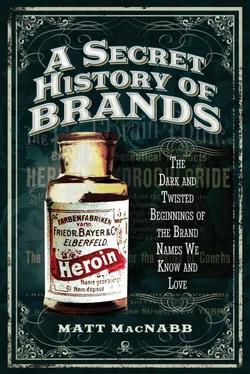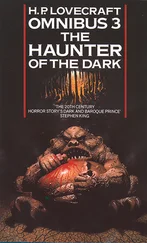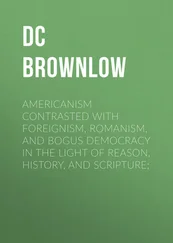Bayer has branded their aspirin with motivational, and telling, slogans such as ‘The More You Know, The More You Trust Bayer’, and ‘Take it for Pain, Take it for Life’. Their most recent, as of the writing of his book, was ‘Expect Wonders’. In fact, they continue to label their aspirin as a pro-heart ‘wonder drug’. Bayer has marketed their aspirin this way, but the reality of a Bayer aspirin regime is that it can reduce instances of a fatal heart attack by ten per cent and non-fatal heart attacks by twenty per cent, but it has been shown to increase gastrointestinal bleeding episodes in thirty per cent of users, according to a 2012 research study.
The marketing of their second major product, heroin-hydrochloride, persisted well into the twentieth century. A Bayer Pharmaceutical Products ad from 1901 markets the drug to pharmacies as a way to manufacture their own remedies like ‘cough elixirs, cough balsams, cough drops, cough lozenges and cough medicines of any kind’. Bayer would also use the slogan: ‘The Sedative For Coughs’, to describe their heroin product. Vintage Bayer adverts in Spanish newspapers around 1912 featured ads that clearly market the use of heroin or ‘heronia’ to children. The adverts feature headlines such as ‘la tos desaparece’, which translates to ‘cough disappears’, and feature doting mothers administering the ‘medicine’ to their offspring.
The bottles were offered in 1oz quantities at a cost of $4.85 per ounce. Allowing for inflation, the cost would be just over $139 per ounce today. Bayer didn’t limit their marketing of heroin as just a cough remedy however; they actually suggested it was a miracle cure-all that could be used for everything from schizophrenia to the common cold. Obviously, we know that none of these claims had any basis whatsoever, but snake oil marketing like this wasn’t uncommon for the era and certainly wasn’t limited to Bayer.
The thought of developing and marketing heroin to the public, much less children, seems particularly heinous. The question has to be asked, can we actually hold Bayer responsible? After all, we didn’t know that heroin was such a dangerous and addictive drug back in those days, right? Unfortunately, that is not necessarily the case. Concerns were raised about the addictiveness of the drug very early on – as early as the year after its release. Bayer was well aware of this concern, but continued to market heroin to children well into the twentieth century. It wasn’t until 1914 that the drug was finally restricted to a prescription-only medication by the Harrison Narcotics Tax Act. Heroin wouldn’t be fully banned from sale and importation until 1924. If heroin were the darkest skeleton in Bayer’s past it would be more than enough, but it is only the beginning of their twisted story.
Bayer and the Nazis
The creation and marketing of heroin to children could perhaps be enough to constitute a seriously dark past, but the skeletons in Bayer’s closet seem to go far deeper than that.
During the Second World War there was a pharmaceutical conglomerate named IG Farben. The IG is short for the German word Interessengemeinschaft, which translates to ‘Association of Common Interests’. IG Farben consisted of eight different companies, BASF, Hoechst, Agfa, Chemische Fabrik Griesheim-Elektron, Chemische Fabrik vorm. Weiler Ter Meer, Cassella, Chemische Fabrik Kalle and Bayer. Bayer wasn’t just a part of the corporate machine, they were actually one of the major players in IG Farben with a 27.4 per cent equity capital investment. IG Farben employed hundreds of thousands of German citizens by the late 1930s and would become the single largest Germany exporter, enjoying a monopoly in the marketplace.
IG Farben decided to go into business with Adolf HItler and his Nazi Party early on and enjoyed a long relationship with the future dictator. In fact, IG Farben would donate significant amounts of money to the National Socialist Party to support their political election campaigns. Adolf Hitler was appointed the German chancellor on 30 January 1933, after a failed attempt at a presidential run in 1932. This new position of power served only to embolden the Nazi Party and they quickly set their sights on the upcoming German elections to be held on 5 March 1933. The Nazis were hoping to gain a majority vote in the Reichstag, so that they could pass the Enabling Act. The Act was a Weimar Constitutional amendment that would give Hitler the ability to enact laws on his own with the approval of the German Cabinet, effectively bypassing any approvals previously needed from the Reichstag. The Act, along with the preceding Reichstag Fire Decree, would pave the way for Hitler’s dictatorship and absolute power in Germany.
A secret meeting was held on 20 February 1933 between Hitler and over two dozen powerful industrialists at Hermann Goering’s home. The purpose behind the meeting was to persuade the big business moguls to invest in the Nazi Party election campaigns for the coming March. The donations came in from several companies, raising over two million Reichsmark, four hundred thousand of those Reichsmark coming from IG Farben alone. IG Farben was reportedly represented at the meeting by board member Georg von Schnitzler. Schnitzler later became a captain in the Nazi Sturmabteilung (aka the Brownshirts). In order to place that donation into context with inflation, that four hundred thousand Reichsmark would be the equivalent to around thirty million dollars (nearly twenty-four million pounds) today. The efforts were for nought, because the Nazis failed to obtain the majority they were seeking in that election. Instead, they rendered any Communist members of the Reichstag unable to vote and threatened any non-Nazi members with violence, winning the vote for the Enabling Act through intimidation.
It was only through the assistance of IG Farben that many of the medical and scientific horrors of the concentration camps were able to proceed. In 1940, IG Farben were looking to build a new factory and they set their sights on Himmler’s largest concentration camp, built in Oswiecim, or Auschwitz, Poland. The site was scouted by Otto Ambros, who found it to be ideal. The plan was to utilise slave labour from the camp to construct their new plant. The result was the Farben Suschwitz plant. It was the financial involvement of IG Farben that took Auschwitz from an obscure backwater of the Nazi extermination plan and pushed it to the forefront, making it the site of one of the largest mass murders in history.
When touring the grim and sorrowful remains of the Auschwitz concentration camp, the museum guides will plainly tell you that IG Farben were behind the Nazis building the Birkenau camp. The camp began, not as an extermination camp like so many others, but as a slave labour camp for IG Farben Industries. Slave labour was an integral part of the Nazi regime, with many companies taking part in the dark practice. The Buna Industrial plant, known as IG Auschwitz, was located approximately 6km from the Auschwitz camp. Buna housed one hundred thousand Soviet prisoners of war and utilised them for slave labour.
The Polish farmers who had been living on the land where the Auchwitz complexes would be constructed were all kicked-off of the land, all of their property destroyed to make way for the death and labour camps in 1940 and 1941. The Nazis utilised some of the raw leftover materials after the farmers’ buildings were destroyed as part of the construction of the camps. It wasn’t until after the Wannsee Conference in 1942 that thousands of innocent Western European Jews were shipped to Birkenau to be slaughtered or enslaved. IG Farben built an industrial complex on the land near Auchwitz to produce their chemicals; thirty thousand slave labourers would die there. When the Adolf Hitler was gearing-up to invade Poland and Czechoslovakia, IG Farben was working closely with the Nazis to secure and seize desired chemical plants in those regions. The conditions within Auschwitz were deplorable. The clothing and living spaces would often become infected with lice or other vermin and when that happened, a deadly chemical fumigant known as Zyklon B was used to treat them and kill the infecting creatures. In fact, the Zyklon B chemical fumigant gas would end up being the method used to kill the Russians, Jews, Gypsies and other prisoners in the Nazi gas chambers. The Nazis were in search of a more economically efficient way to mass-murder their prisoners and it was Auschwitz deputy Karl Fritzsch who first thought up the idea of using the gas to kill humans in the camp. This gas was produced by Fritz Haber’s company, Degesch (Deutsche Gesellschaft fur Schadlingsbekampfung). Degesch utilised the evil product under licence from IG Farben who, in turn, owned 42.2 per cent of the shares in Degesch. Experiements that IG Farben were involved in included the forced testing of drugs on prisoners – including what would become the first round of chemotherapy treatments. Nazi SS Major Dr med. Helmuth Vetter was an employee of IG Farben. Vetter was the notorious chief doctor at Auschwitz and was himself often responsible, along with the other doctors there, for selecting which Jews would face the gas chambers. The Nazi SS Dr Hoven would testify the following at the Nuremberg trials:
Читать дальше












